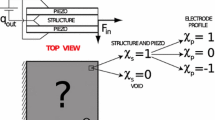Summary
Following the topic introduced in [1, 2] this paper discusses the design of piezoelectric transducers used in applications such as acoustic wave generation and resonators. These applications require goals in the transducer design such as high electromechanical energy conversion for a certain transducer vibration mode and narrowband or broadband response. The development of these devices has been based on the use of simple analytical models, test of prototypes, and analysis by the finite element method. However, in all cases the design is limited to a parametric optimization where only some dimensions of a chosen transducer configuration are optimized. By changing the topology of these devices or their components, we may obtain devices with better performance since the design space of solutions is enlarged. Based on this idea, we have proposed the use of topology optimization for designing these devices. This method consists of finding the distribution of the material and void phases in the design domain that optimizes a defined objective function. The optimized solution is obtained using Sequential Linear Programming (SLP). Considering acoustic wave generation and resonator applications, three kinds of objective functions were defined: maximize the energy conversion for a specific mode or a set of modes; design a transducer with specified frequencies; and design a transducer with narrowband or broadband response. Although only two-dimensional plane strain transducer topologies have been considered in order to illustrate the implementation of the method, it can be extended to three-dimensional topologies. Transducer designs were obtained that conform to the desired design requirements and have better performance characteristics than other common designs.
Similar content being viewed by others
References
Silva, E.C.N., J.S.O. Fonseca, F.M. de Espinosa, A.T. Crumm, G.A. Brady, J.W. Halloran and N. Kikuchi (1999), “Design of Piezocomposite Materials and Piezoelectric Transducers Using Topology Optimization—Part I”,Archives of Computational Methods in Engineering, Vol.6 No.2, 117–182.
Silva, E.C.N., S. Nishiwaki, and N. Kikuchi (1999), “Design of Piezocomposite Materials and Piezoelectric Transducers Using Topology Optimization—Part II”,Archives of Computational Methods in Engineering, Vol.6 No. 3, 191–222.
Kunkel, H.A., S. Locke, and B. Pikeroen (1990), “Finite Element Analysis of Vibrational Modes in Piezoelectric Ceramic Disks”,IEEE Transactions on Ultrasonics, Ferroelectrics and Frequency Control,37 No. 4, 316–328.
Simson, É.A. and A. Taranukha (1993), “Optimization of the Shape of a Quartz Resonator”,Acoustical Physics,39 No. 5, 472–476.
Challande, P. (1990), “Optimizing Ultrasonic Transducers Based on Piezoelectric Composites Using a Finite-Element Method”,IEEE Transactions on Ultrasonics, Ferroelectrics and Frequency Control,37, No. 2, 135–140.
Sato J., M. Kawabuchi, and A. Fukumoto (1979), “Dependence of the Electromechanical Coupling Coefficient on the Width-to-thickness Ratio of Plank-shaped Piezoelectric Transducers Used for Electronically Scanned Ultrasound Diagnostic Systems”,The Journal of the Acoustical Society of America,66, No. 6, 1609–1611.
Naillon, M., R.H. Coursant, F. Besnier (1983), “Analysis of Piezoelectric Structures by a Finite Element Method”,Acta Electronica,25 4, 341–362.
Lerch, R. (1990), “Simulation of Piezoelectric Devices by Two- and Three-Dimensional Finite Elements”,IEEE Transactions on Ultrasonics, Ferroelectrics and Frequency Control,37 No. 2, 233–247.
Guo, N., P. Cawley, and D. Hitchings (1992), “The Finite Element Analysis of the Vibration Characteristics of Piezoelectric Discs”,Journal of Sound and Vibration,159 No. 1, 115–138.
Yong, Y-K. (1995), “A New Storage Scheme for the Lanczos Solution of Large Scale Finite Element Models of Piezoelectric Resonators”,Proceedings of IEEE Ultrasonics Symposium, 1633–1636.
Yong, Y-K. and Y. Cho (1994), “Algorithms for Eigenvalue Problems in Piezoelectric Finite Element Analysis”,Proceedings of IEEE Ultrasonics Symposium, 1057–1062.
Yang, R.J. and C.H. Chuang (1994), “Optimal Topology Design Using Linear Programming”,Computers & Structures,52 No. 2, 265–275.
Sigmund, O. (1996), “On the Design of Compliant Mechanisms Using Topology Optimization”,Danish Center for Applied Mathematics and Mechanics, Report No. 535.
Ma, Z-D., N. Kikuchi, and H.-C. Cheng (1995), “Topological Design for Vibrating Structures”,Computer Methods in Applied Mechanics and Engineering,121, 259–280.
Díaz, A.R. and N. Kikuchi (1992), “Solutions to Shape and Topology Eigenvalue Optimization Problems Using a Homogenization Method”,International Journal for Numerical Methods in Engineering,35, 1487–1502.
Yao, Q. and L. Bjorno (1997), “Broadband Tonpilz Underwater Acoustic Transducers Based on Multimode Optimization”,IEEE Transactions on Ultrasonics, Ferroelectrics, and Frequency Control,44 No. 5, 1060–1066.
Vanderplaatz, G.N. (1984),Numerical Optimization Techniques for Engineering Design: with Applications, McGraw-Hill, NY.
Hanson, R. and K. Hiebert (1981), “A Sparse Linear Programming Subprogram”,Sandia National Laboratories, Technical Report SAND81-0297.
Bendsøe, M.P. (1989), “Optimal Shape Design as a Material Distribution Problem”,Structural Optimization,1, 192–202.
Bremicker, M., M. Chirehdast, N. Kikuchi, and Y. Papalambros (1991), “Integrated Topology and Shape Optimization in Structural Design”,Mechanics of Structures and Machines,19 No. 4, 551–587.
Meric, R.A. and S. Saigal (1991), “Shape Sensitivity Analysis of Piezoelectric Structures by the Adjoint Variable Method”,AIAA Journal,29 No. 8, 1313–1318.
Smith, W.A. and B.A. Auld (1991), “Modeling 1–3 Composite Piezoelectrics: Thickness-Mode Oscillations”,IEEE Transactions on Ultrasonics, Ferroelectrics, and Frequency Control,38 No. 1, 40–47.
Bandyopadhyay, A., R.K. Panda, V.E. Janas, M.K. Agarwala, S.C. Danforth, and A. Safari (1997), “Processing of Piezocomposites by Fused Deposition Technique”,Journal of the American Ceramic Society,80 No. 6, 1366–1372.
Haftka, R.T., Z. Gürdal, and M.P. Kamat (1992),Elements of Structural Optimization, Dordrecht: Kluwer Academic.
Author information
Authors and Affiliations
Rights and permissions
About this article
Cite this article
Nelli Silva, E.C., Kikuchi, N. Design of piezocomposite materials and piezoelectric transducers using topology optimization— Part III. Arch Computat Methods Eng 6, 305–329 (1999). https://doi.org/10.1007/BF02818918
Received:
Issue Date:
DOI: https://doi.org/10.1007/BF02818918




